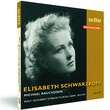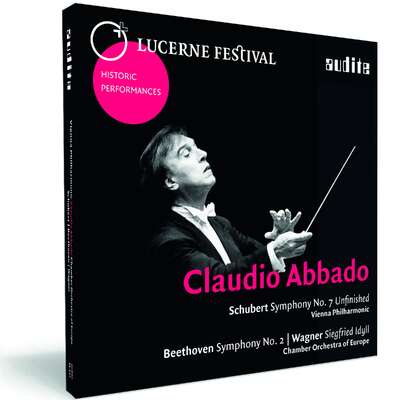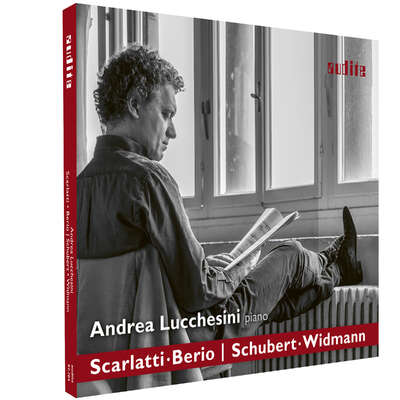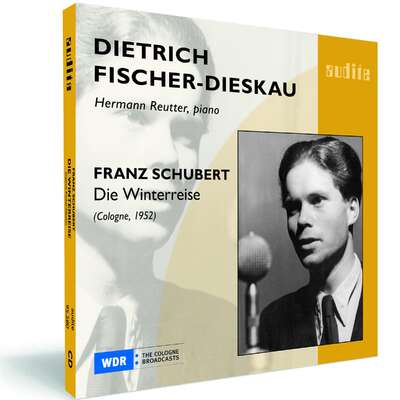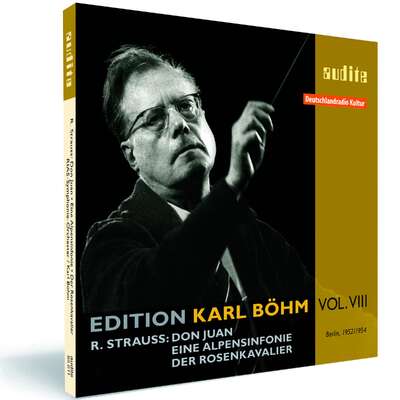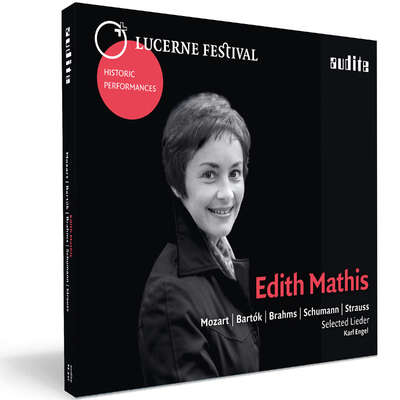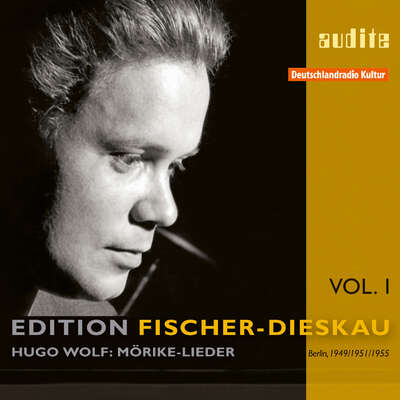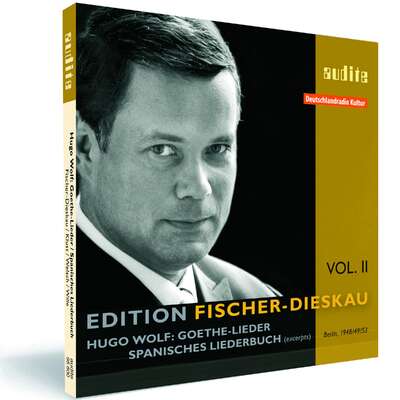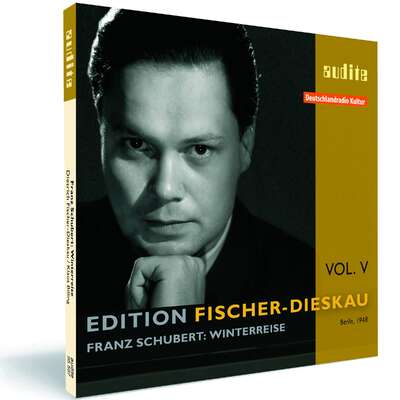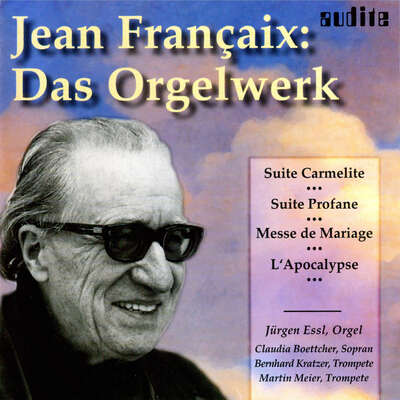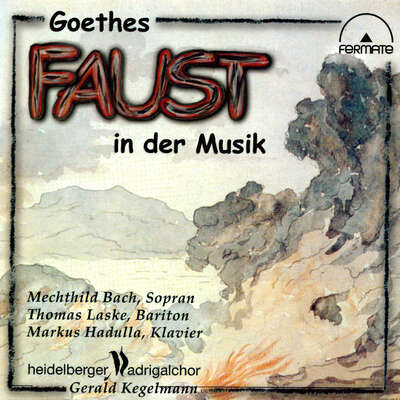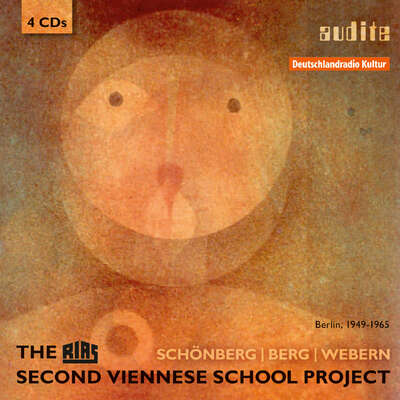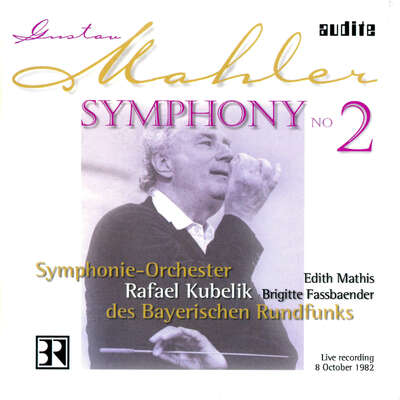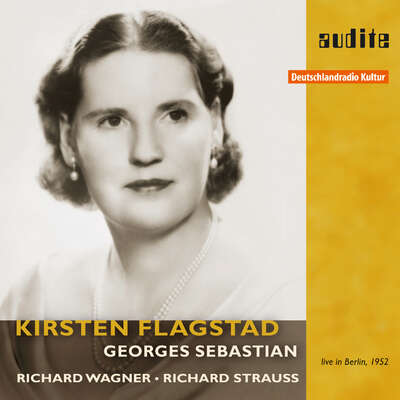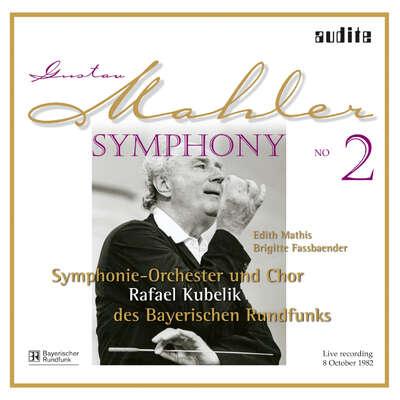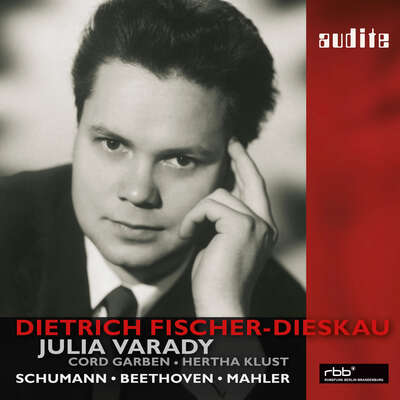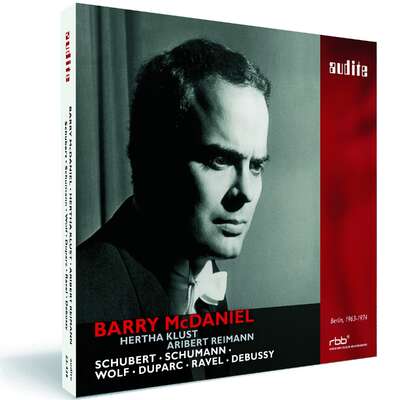
A document out of the ordinary: Elisabeth Schwarzkopf’s Lied recordings with her accompanist Michael Raucheisen, made on 6 January 1958 at the RIAS studios in Berlin, are an impressive example of the fruitful cooperation between these two artists. They performed together as early as 1942, at the...more
"Die Schwarzkopf befindet sich hier auf dem Höhepunkt ihres Könnens und erklimmt einen wahrhaft einsamen Gipfel. Verglichen mit dieser Ausleuchtung vertonter Dichtkunst wirkt der Liedgesang vieler anderer Kolleginnen etwas unterbelichtet." (Westdeutsche Zeitung)
Details
| Elisabeth Schwarzkopf interprets songs by Wolf, Schubert, Strauss, Purcell, Arne & Quilter | |
| article number: | 95.633 |
|---|---|
| EAN barcode: | 4022143956330 |
| price group: | BCB |
| release date: | 24. April 2009 |
| total time: | 64 min. |
Bonus Material
Informationen
A document out of the ordinary: Elisabeth Schwarzkopf’s Lied recordings with her accompanist Michael Raucheisen, made on 6 January 1958 at the RIAS studios in Berlin, are an impressive example of the fruitful cooperation between these two artists. They performed together as early as 1942, at the beginning of Elisabeth Schwarzkopf’s glittering career, and more than one and a half decades later this artistic partnership drew to a close with these recordings.
These interpretations of selected songs by Wolf, Schubert and Strauss, made available for the first time, reveal new facets of her creative art. The CD is completed with music by Purcell, Arne and Quilter – Elisabeth Schwarzkopf and Michael Raucheisen at the height of their abilities.
There is a “Producer’s Comment” from producer Ludger Böckenhoff about this production available.
The production is part of our series „Legendary Recordings“ and bears the quality feature „1st Master Release“. This term stands for the excellent quality of archival productions at audite. For all historical publications at audite are based, without exception, on the original tapes from broadcasting archives. In general these are the original analogue tapes, which attain an astonishingly high quality, even measured by today‘s standards, with their tape speed of up to 76 cm/sec. The remastering – professionally competent and sensitively applied – also uncovers previously hidden details of the interpretations. Thus, a sound of superior quality results. CD publications based on private recordings from broadcasts cannot be compared with these.
Reviews
France Musique | lundi 8 novembre 2010 | Frédérique Jourdaa | September 8, 2010 BROADCAST Le point du jour
Sendebeleg siehe PDF!Mehr lesen
orpheus | Heft 5+6 / Mai + Juni 2010 | Sebastian Sternberg | May 1, 2010 Historische Schätze von audite und anderen
Die Zusammenarbeit des Labes audite mit Deutschlandradio Kultur, dem Rechtsnachfolger des RIAS, erweist sich als sehr ertragreich. Sie führt in dasMehr lesen
Vol. I seiner eigenen Edition sind Mörike-Lieder von Wolf (95.599). Es wurden Aufnahmen von 1949, 1951 und 1955 zusammengefasst. Am Klavier sitzen Hertha Klust und Rudolf Wille. Auch beim Liedgesang ist mir der junge Fischer-Dieskau lieber als der reifere. Er geht die einzelnen Stücke viel freier an, folgt dem „inneren Triebe“ und setzt nicht ein ganzes Gebäude aus Erfahrung, Deutungswillen und Sendungsbewusstsein drauf. Die Lieder fließen mehr und schleppen sich nicht bedeutungsschwer und belehrend dahin.
Elisabeth Schwarzkopf ist 1958 ins RIAS Studio gegangen und hat dort gemeinsam mit Michael Raucheisen Lieder aufgenommen (95.633). Die Interpretation der Wolf-Lieder ist schon stark geprägt durch ihren Ehemann und Mentor Walter Legge, der die Renaissance dieses Komponisten maßgeblich beförderte. Die meisten betörenden Details kehren in den Produktionen unter seiner Leitung wieder bzw. wurden dort bereits erarbeitet. Akzente auf dieser CD werden vor allem von Raucheisen gesetzt, der vor allem bei Wolf dramatischer und zupackender begleitet als der Schwarzkopfsche „Hauspianist“ Gerald Moore. Neben Wolf gibt es Schubert, Strauss, Purcell, Thomas Arne und Roger Quilter. Alle Titel dürften Premieren auf den Musikmarkt sein. Schon diese Tatsache verleiht ihnen Exklusivität und verheißt Sammlerglück.
Dem grauen Markt entrissen wurde Verdis Messa da Requiem, mit dem als Vol. I eine Herbert-von-Karajan-Reihe eröffnet wird (23.415). Es ist der Salzburger Mitschnitt von 1949, bei dem Karajan noch nach Ausdrucksformen für dieses Werk sucht, das ihn ein Leben lang beschäftigen sollte. In der Besetzung treffen mit Hilde Zadek, Margarete Klose, Helge Rosvaenge und Boris Christoff Vergangenheit, Gegenwart und Zukunft aufeinander. Das Klangbild dieser restaurierten Fassung nach den Originalbändern ist wesentlich präsenter als das, was von dieser Aufführung bisher zu haben war. Es lohnt sich also, die alte durch die neue Ausgabe zu ersetzen.
Karajan bleibt auch bei anderen Labels ein Star. Jade, Frankreich, hat die berühmte, inzwischen freie EMI-Einspielung der h-Moll-Messe von Bach herausgegeben, die als erste Schallplattenaufnahme von Nicolai Gedda gilt (699 649-2). Membran ist einfallsreicher und hat unter dem Titel „Herbert von Karajan in Berlin“ noch frühere Dokumente des Dirigenten ausfindig gemacht (232482). Einmal ist es Beethovens Eroica mit der Preußischen Staatskapelle, 1944 im Haus des Rundfunks an der Berliner Masurenallee aufgenommen, zum anderen Bruckners 8. Sinfonie mit dem gleichen Orchester, im gleichen Jahr an gleicher Stelle eingespielt. Der erste Satz fehlt, der vierte und letzte ist ein früher Versuch von Stereofonie. Diese Technikbesessenheit sollte den Dirigenten nie mehr loslassen.
Classica | Numéro 117 - novembre 2009 | André Tubeuf | November 1, 2009 Archives lyriques
Renata scotto esta l'honneur ce moi-ci, mais aussi le metropolitan de NewMehr lesen
cdhotlist.btol.com | October 2009 | Peter Szabo | October 1, 2009
This is part of Audite's Legendary Recordings series which makes availableMehr lesen
www.amazon.de | 4. September 2009 | September 4, 2009 | source: https://www.amaz... Customer Review: Artistry at it's height
This recital finds Schwarzkopf at the height of her vocal & artistic powers, and has the added bonus of being accompanied by one of her "teachers",Mehr lesen
It is nice to have this collaboration of "teacher & pupil", it being shortly before his retirement.
International Record Review | September 2009 | Roger Pines | September 1, 2009
At the time of that rally, Elisabeth Schwarzkopf was at the beginning of her illustrious career. Twenty years later, long an established 'star', sheMehr lesen
American Record Guide | September/October 2009 | Boyer | September 1, 2009
Audite has obtained access to the original tapes for these 1958 recording sessions that Elisabeth Schwarzkopf made with pianist Michael Raucheisen forMehr lesen
The song texts are in the original languages only (German, of course, for the Wolf, Schubert, and Strauss that make up the bulk of the program; English for the unexpected selections by Purcell, Arne, and Quilter). The notes dwell mostly on Schwarzkopf's career (a bit too indulgently), making reference to the program material only when it has a bearing on her artistic development.
Beyond this what can one say about an artist whose position is so firmly established? We hear the 43-year-old Schwarzkopf near the peak of her powers, which should be self-recommending to her admirers seeking to fill out their collections with as yet unheard performances. For the general collector, though, her commercial releases from that period will probably suffice.
Ópera Actual | septiembre 2009 | Albert Torrens | September 1, 2009
Acostumbrados a reconocer en Schwarzkopfa la excelsa intérprete de MozartMehr lesen
Arte | Sommer 2009 | Mathias Heizmann | July 21, 2009
Klassik
Spezial "Sommer 2009"
Ferien sollen erholsam sein, aber warum sollen sie nicht auch derMehr lesen
Das Opernglas | Juli/August 2009 | Lars-Erik Gerth | July 1, 2009
Als Elisabeth Schwarzkopf im Januar 1958 mit dem renommierten LiedbegleiterMehr lesen
Classic Record Collector | Summer 2009 | John Steane | July 1, 2009 Elisabeth Schwarzkopf
The vitality here – the deep and quick play of mind, spirit and technique – is newly astonishing. One thinks one knows Schwarzkopf, and certainlyMehr lesen
These alone would make the complete broadcast recital an essential acquisition even for those who have caught up with the items previously issued on other labels. The Wolf songs were omitted, as was Purcell's wonderful Blessed Virgins Expostulation, a piece which Schwarzkopf included in several of her recitals in the early 1950s but which is new to the discography. That and Music for a while are lovely examples of the singer's art – and were no doubt chosen to remind listeners that, as she had been a proud ambassadress of the Lied in other countries, so she would now like to bring to Germans the songs of her adopted country by marriage.
For Raucheisen's part in the recital, if at first it seems a little dry and professorial (his renunciation of the sustaining pedal almost too virtuous), that disappears as he enters passionately into the pounding insistencies of Kennst du das Land? In the postlude to Epiphanias he is clearly visualizing with humour and relish the procession of childkings, and in Arne's setting of Where the bee sucks he brings a rhythmic touch achieved by the welljudged play of legato and staccato. The piano itself, if not a period instrument, is appropriately mellow in tone and free from any late-Romantic stridency. The recorded sound, digitally remastered, is not entirely innocent of the hard glare which so often seems to be accepted as the modern guarantee that the engineer has done his improving work. For most of the time the voice is beautifully reproduced but for the occasional exceptions I know what she would have said: "Well, they can say all sorts of things about my singing but I don't think I was ever harsh".
CD Compact | Julio 2009 | Benjamín Fontvella | July 1, 2009
Estos volúmenes (segundo y tercero de la colección dedicada a Karajan) seMehr lesen
Westdeutsche Zeitung | 6. Juni 2009 | Dr. Lars Wallerang | June 6, 2009 Einsamer Gipfel
Auf dem Gebiet des Kunstliedes, wo ein Sänger gleichzeitig die WortspracheMehr lesen
WDR 3 | Tonart, Dienstag, 02.06.09 um 15:05 Uhr | Kirsten Liese | June 2, 2009
Schwarzkopf: Lieder
Aufnahmen von 1958
Das markante Timbre ist unverkennbar, aber einige Raritäten hört man zumMehr lesen
Diverdi Magazin | Junio 2009, Nr. 182 | Roberto Andrade | June 1, 2009
No va más
Fantástica muestra del arte de la Schwarzkopf en Audite
Tantas veces he ensalzado en este Boletín el arte excelso de Elisabeth Schwarzkopf –elmes pasado, sin ir más lejos– que el riesgo de repetirMehr lesen
Examinemos de cerca un trío de lieder. En primer lugar, la emoción desbordante de Kennst du das Land, de Hugo Wolf, bellísima canción, favorita de la soprano y de cualquiera que se la haya escuchado: es difícil interpretarla mejor. En contraste, la dulzura de la Canción de cuna de Richard Strauss, que exige un control del aliento impecable para mantener ese legato etéreo sin el que la obra perdería su sentido; y el humor de Hat gesat o de Schlechtes Wetter, del mismo autor. El pianista colaborador es, en esta ocasión, el ilustre Michael Raucheisen, maestro de la soprano en los años 40 y marido de Maria Ivogün, profesora de canto de la Schwarzkopf. Con esos antecedentes, ¿puede alguien dudar de que la compenetración fue perfecta? Estupendo sonido, excelentes notas de carpeta de Detlef Giese, y textos en lengua original. No se lo pierdan bajo ningún concepto.
Arte | November 30, 2008 Spécial été 2009
Si les vacances ont vocation à être agréables, rien ne leur interditMehr lesen
